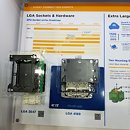
Thermaltake Launches the WAir CPU Cooler for Workstations
Thermaltake has launched the WAir CPU Cooler a cooling solution for workstations that handle demanding tasks like 3D rendering and AI processing. This cooler supports Intel LGA4677 and AMD sTR5/SP6 sockets and is capable of delivering up to 500 W TDP cooling capacity. It measures 143.2 x 115 x 165 mm (L x W x H) and has a single-tower design with aluminium fins. Thermaltake WAir cooler features six 6 mm diameter heat pipes connected to a large nickel plated copper base with high-quality solder paste between heat pipes and heat sinks to enhance thermal conductivity.
The WAir uses two upgraded TOUGHFAN 14 Pro units. Each fan is 140.8 x 140.8 x 26.4 mm in size and runs at speeds from 500 to 1500 RPM controlled by PWM. Users can adjust the fan positions to fit different memory module heights. The fans have liquid crystal polymer (LCP) blades that help reduce vibration at top speeds. Each fan delivers up to 83.4 CFM airflow with 1.86 mm-H₂O static pressure and 24.4 dBA noise levels. The fans connect with 4-pin PWM connectors and offer 50,000 hours of operational life. Thermaltake didn't provide exact pricing and availability for the WAir CPU cooler series.
The WAir uses two upgraded TOUGHFAN 14 Pro units. Each fan is 140.8 x 140.8 x 26.4 mm in size and runs at speeds from 500 to 1500 RPM controlled by PWM. Users can adjust the fan positions to fit different memory module heights. The fans have liquid crystal polymer (LCP) blades that help reduce vibration at top speeds. Each fan delivers up to 83.4 CFM airflow with 1.86 mm-H₂O static pressure and 24.4 dBA noise levels. The fans connect with 4-pin PWM connectors and offer 50,000 hours of operational life. Thermaltake didn't provide exact pricing and availability for the WAir CPU cooler series.






























































